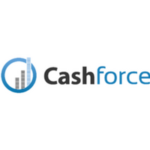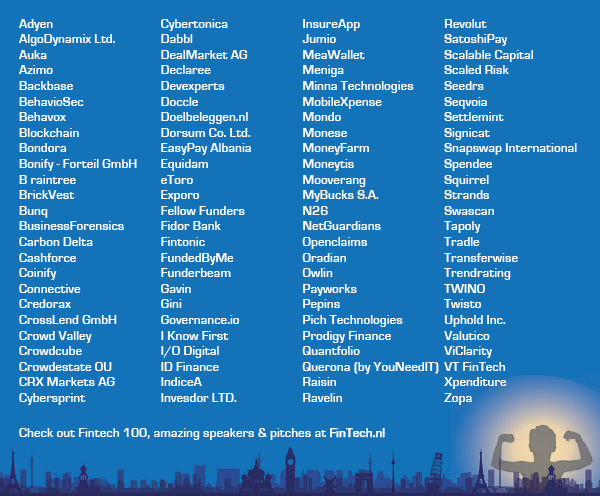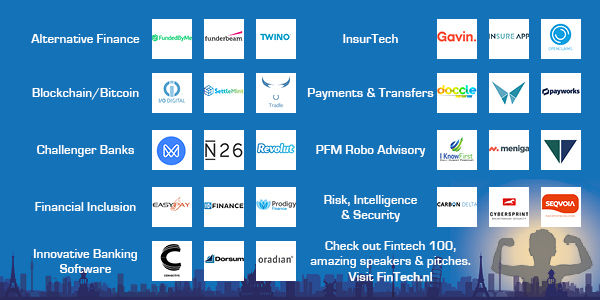Cashforce raises €2 Million to accelerate international rollout
| 27-02-2018 | Nicolas Christiaen | Cashforce | sponsored content |
 Cashforce, a fintech leader in Cash forecasting & Treasury solutions for corporates, announced today that it has closed € 2 million in Series A financing. The internal funding round was led by Volta Ventures and Michel Akkermans (Pamica NV), reinforcing their previous commitment to the company. The Series A financing enables Cashforce to accelerate the ongoing international roll-out and fuels its rapid global growth and industry leadership as a premier provider of Cash forecasting & Treasury solutions. Organisationally, staff will be expanded, and operations will be scaled up – with a significant number of new hires in 2018. Product-wise the company is working on developments that will enable even more insights and potential savings for its clients. Commercially, supporting and growing the customer base and increasing customer success and adoption as well as continuing to build strategic partnerships and alliances are part of the strategic plan.
Cashforce, a fintech leader in Cash forecasting & Treasury solutions for corporates, announced today that it has closed € 2 million in Series A financing. The internal funding round was led by Volta Ventures and Michel Akkermans (Pamica NV), reinforcing their previous commitment to the company. The Series A financing enables Cashforce to accelerate the ongoing international roll-out and fuels its rapid global growth and industry leadership as a premier provider of Cash forecasting & Treasury solutions. Organisationally, staff will be expanded, and operations will be scaled up – with a significant number of new hires in 2018. Product-wise the company is working on developments that will enable even more insights and potential savings for its clients. Commercially, supporting and growing the customer base and increasing customer success and adoption as well as continuing to build strategic partnerships and alliances are part of the strategic plan.
“Cash management & Treasury is evolving from a focus on data acquisition to Treasury automation and data analysis, enabling Treasury departments to bridge the gap between the Finance and other operational departments and enable data-driven strategic decision making. On top of that, Cash flow forecasting has become the major focus of the industry.”, said Nicolas Christiaen, CEO and co-founder of Cashforce. “This investment also re-confirms our investors’ confidence in the leadership that Cashforce has established in the Treasury space, our continued rapid growth and the potential to re-define the category.”
Additionally, Cashforce announced that Michel Akkermans will become Chairman of the board. Michel Akkermans is a serial entrepreneur in fintech companies. Amongst others, he was the Chairman and CEO of successful companies such as FICS and Clear2Pay. After the global payment solution company Clear2Pay was acquired by FIS in 2014, he became an active investor and board member in several companies and private equity organisations, as well as a venture partner and Chairman of Volta Ventures.
Cashforce: The Leading Cash forecasting platform for the Modern Corporate
Cashforce is a next-generation Cash forecasting & Smart Treasury Management System, focused on automation and integration for corporates. It helps corporate finance/treasury departments save time and money by offering accurate cash flow forecasting, pro-active working capital management analysis as well as flexible Treasury reporting & automation.
Cashforce is unique because it offers full transparency into what exactly drives the cash flow of mid-size & large corporates with different complexities such as multi-entity, multi-bank, multi-currency and complex ERP(s). Smart algorithms are applied to generate highly accurate Cash forecasts. The intelligent simulation engine enables companies to consider multiple scenarios and measure their impact. Its intuitive user interface allows for extensive and tailor-made analysis & reporting possibilities. Unlike other enterprise software players, the platform is set up quickly, even in the most complex environments, and connecting seamlessly with any ERP system through its ‘plug-and-play’ connectors. As a result, finance/treasury departments can be turned into business catalysts for cash generation opportunities throughout the company.
“While we started off as a Cash forecasting tool, we have added Advanced Working Capital analytics and Smart Treasury functionalities, and are now operative as a comprehensive modular Treasury Management System (TMS). This makes Cashforce a one-stop-shop for the many analytical and operational practices that benefit Financial and Treasury departments,” says Nicolas Christiaen, CEO of Cashforce. “The endorsement we get from both industry experts and clients progressively confirms that our solution really does bring change into the Treasury market. We now see that potential customers compare the classical TMS providers to Cashforce with Cashforce ending up as the preferred solution! Then you know you’re on the right track. We therefore strive to continue our vision to further integrate and automate to provide our customers with an even more effortless experience.”
“Cashforce has brought a very compelling solution to the corporate Cash management market, which is clearly seen in its results. Since its last financial injection in early 2016, Cashforce has demonstrated a rapid growth, including well over 100% annually recurring revenue growth”, explains Michel Akkermans, the company’s recently appointed chairman.
“With a surge in employees to over 25, an increasing and global interest from the market and partnerships with leading corporate banks, private equity firms & Treasury consultants, Cashforce has been expanding both reach and product. We have heard back from multiple existing customers about their positive experiences with the solution and its impact on their business, and they strongly believe in its trajectory moving forward”.
“Cashforce set foot in the Netherlands this year and has been growing substantially, proving that the company can be scaled up relatively easy,” says Nicolas Christiaen. “This would not be the case without the help of Volta Ventures and Michel Akkermans, who not only provided funding, but also lent their vast strategic experience in our market. The plans for Western-Europe as well as the US are outlined, and this funding round will be valuable to accelerate the international roll-out.”
About Cashforce (www.cashforce.com)
Cashforce is a ‘next-generation’ Cash forecasting & Smart Treasury platform, focused on integration and automation. With its technology, Cashforce is helping Treasury departments from large capital-intensive businesses save time and money by offering cash visibility & pro-active cash saving insights. The platform is easy to use and install, and connects seamlessly with any ERP system. Cashforce is headquartered in Belgium with an office in Amsterdam and New York, serving customers globally such as TomTom, Hyundai and Greenyard among many others worldwide.
About Pamica (www.pamica.be)
Pamica is the investment company of Michel Akkermans.
About Volta Ventures (www.volta.ventures)
Volta Ventures Arkiv invests in young and ambitious internet and software companies in the Benelux. The fund has € 55 million under management and is supported by EIF and ARKimedesFund II.
Press Contact Information
Nicolas Christiaen – [email protected] – +32 479 65 52 95
Michel Akkermans (Pamica NV) – [email protected] – +32 3 202 40 30

 During our stay in South Africa I was reading an article in Die Burger (newspaper for Afrikaners) where a spokesman of Cape town-based PWC gave his ideas on the recent rise of Bitcoin and the future of Blokketting (Afrikaans for Blockchain). This inspired me to write this blog. Since I started writing about blockchain I categorically refused to use the term Bitcoin. But this time it is different. As Bitcoin nears the end of a record-breaking year, it seems an appropriate time to dive into this – by many traditional players said – over-hyped thing. Others describe this fascination for Bitcoins as a “speculative mania”. The broader public has discovered this phenomenon. I will not say it is (already) the end of the rise in Bitcoins or other crypto currencies. But let me be clear: Bitcoin is a lot not!
During our stay in South Africa I was reading an article in Die Burger (newspaper for Afrikaners) where a spokesman of Cape town-based PWC gave his ideas on the recent rise of Bitcoin and the future of Blokketting (Afrikaans for Blockchain). This inspired me to write this blog. Since I started writing about blockchain I categorically refused to use the term Bitcoin. But this time it is different. As Bitcoin nears the end of a record-breaking year, it seems an appropriate time to dive into this – by many traditional players said – over-hyped thing. Others describe this fascination for Bitcoins as a “speculative mania”. The broader public has discovered this phenomenon. I will not say it is (already) the end of the rise in Bitcoins or other crypto currencies. But let me be clear: Bitcoin is a lot not!
 With the steady rise of Fintech within the finance industry some people are already calling for the demise of banks as the historical financial partner of choice for corporates. Certainly, Fintech is showing itself to be very dynamic, offering many new products and solutions, and being a lot swifter than the banks. Banks seem to have grown too big and complacent, are being weighed down by new rules and regulations, are less prominent in the field of funding for corporates, and possibly have lost their focus on what used to be core businesses. But let us examine the relationship between bank and client.
With the steady rise of Fintech within the finance industry some people are already calling for the demise of banks as the historical financial partner of choice for corporates. Certainly, Fintech is showing itself to be very dynamic, offering many new products and solutions, and being a lot swifter than the banks. Banks seem to have grown too big and complacent, are being weighed down by new rules and regulations, are less prominent in the field of funding for corporates, and possibly have lost their focus on what used to be core businesses. But let us examine the relationship between bank and client. In May this year, fintech start-up R3 raised $107 million from a consortium of the world’s top banks. The New York-based blockchain company that works in collaboration with more than 90 banks and other financial organizations world-wide, plans to use the money to invest in further developing the Corda platform (see my blog: Corda: distributed ledger ….. not blockchain! April 6, 2016) as well as “encouraging entrepreneurs to start building on the platform though training videos and hackathons”.
In May this year, fintech start-up R3 raised $107 million from a consortium of the world’s top banks. The New York-based blockchain company that works in collaboration with more than 90 banks and other financial organizations world-wide, plans to use the money to invest in further developing the Corda platform (see my blog: Corda: distributed ledger ….. not blockchain! April 6, 2016) as well as “encouraging entrepreneurs to start building on the platform though training videos and hackathons”. 




 Microsoft recently announced the introduction of the
Microsoft recently announced the introduction of the  Op 27 september is het zover. Buitenlandse investeerders en FinTech-specialisten van naam reizen dan af naar Brussel. Tijdens de
Op 27 september is het zover. Buitenlandse investeerders en FinTech-specialisten van naam reizen dan af naar Brussel. Tijdens de 

 Annette Gillhart – Community Manager treasuryXL
Annette Gillhart – Community Manager treasuryXL

